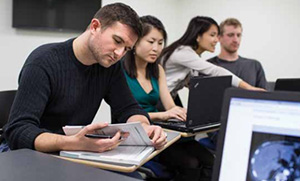

Renovations and Innovations
Einstein's New Education Center
Introducing…Einstein's Education Center, located in facilities stretching from the Leo Forchheimer Medical Science Building through the Michael F. Price Center for Genetic and Translational Medicine/Harold and Muriel Block Research Pavilion and on into the Van Etten Building. "Our new Education Center is the most important development in medical education at Einstein in its nearly 60-year history," says Allen M. Spiegel, M.D., Einstein's Marilyn and Stanley M. Katz Dean. The Education Center's key facilities are:

This article originally appeared in Philanthropy at Einstein.
The Large-Group Active Learning Studio
It replaces the lower stacks of the library in Forchheimer. This space accommodates an entire medical school class and up to 20 faculty members doing interactive, large-group exercises. Pulling out soundproof partitions divides the studio into rooms in which small groups of students sit at tables to solve problems.
Small-Group Active Learning Studios
These more intimate spaces feature interactive learning and have been created where the library's upper stacks used to be. They're designed to foster collaborative, project-based activities. Furniture in these smaller rooms is movable, in the interest of offering students a dynamic learning experience. Team-based learning is emphasized in both the large-group and small-group active learning studios. "Medical education is increasingly moving toward team-based learning —it's the most important educational method that our renovations have made possible," says Martha S. Grayson, M.D., senior associate dean for medical education. "Team-based learning can work with a group of six or a classroom of 200, and every student is actively engaged." Victoria H. Freedman, Ph.D., associate dean for graduate programs in biomedical sciences, notes that grad students also use the large-group and small-group active learning studios, since many courses in the new graduate curriculum emphasize team-based learning.
The Theater-Based Learning Studio

Movable furniture makes it easy for students to gather in small groups for team problem solving. "This was a unique idea," says Dr. Grayson. The new Van Etten facility arose from an old, long-unused 90-seat auditorium in need of extensive renovation. She and Salvatore P. Ciampo, senior director of facilities management, made a plan to install swiveling chairs in the auditorium, allowing medical students to face forward for a large-group lecture, and then rotate to form groups of six for problem-solving in smaller groups, says Dr. Grayson. The innovative architecture is ideal for the team-based learning exercises that are an integral part of the new graduate curriculum, and it's just the right size for some of the larger groups, says Dr. Freedman. The auditorium will also serve as a site for online testing and facultydevelopment programs.
The Simulation Center
Students entering the Simulation Center, located in Van Etten, will be greeted by their professors and by computerized mannequins that can blink, sweat, breathe and more—giving the students a way to work with almost-real patients. Studies show that practicing high-risk skills on mannequins translates into better performance when doing procedures such endoscopic surgery and in team-based emergency situations such as acute cardiac and respiratory resuscitation.
The Anatomic and Surgical Skills Learning Center
Finally, Einstein's anatomy laboratory will move from Forchheimer to Van Etten to be closer to the Gottesman Clinical Skills Center and the Simulation Center. The new, expanded Anatomic and Surgical Skills Learning Center will allow for a mix of anatomy, histology, pathology and radiology training. "We wanted our space to allow students to integrate what they are learning in anatomy, histology and pathology with their roles as future physicians," says Dr. Grayson. The center will be set up so that a student can work on a cadaver, correlate findings with relevant histology and pathology slides and then view relevant radiologic images, such as MRIs and CT scans.
Posted on: Thursday, June 12, 2014

Tablet Blog